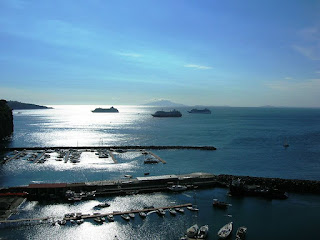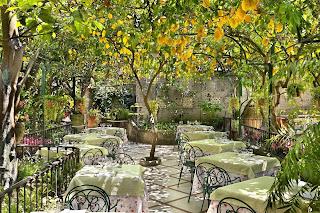Historic port is a transport hub for locals and tourists
 |
The harbour at Marina Piccola, the departure point
for trips to Naples, Capri and elsewhere |
Marina Piccola (small marina) is Sorrento’s main port, from where the car ferries and hydrofoils depart for Naples, the islands of Capri, Procida and Ischia, and the Amalfi coast. Confusingly for visitors to Sorrento, Marina Grande (big marina), Sorrento’s other port, has more of the atmosphere of a fishing village, with small boats lined up on its beach and a good choice of restaurants, bars, and shops.
At one time, Marina Piccola could be reached only by a long flight of steps, but now there is a road - Via Luigi de Maio - leading to it from Piazza Tasso, which buses and taxis use to transport hundreds of local people and visitors up and down each day.
A double lift was installed in Villa Comunale, which overlooks the port, in 2012, to save passengers from the uphill walk when they have arrived by boat. With a capacity of eight passengers in each lift, it replaced an earlier, single-shaft elevator that closed in 2006.
 |
The pretty Church of Santa Maria
del Soccorso at Marina Piccola |
The cost to ride up or down in the lift is 1.10 euro and it is in operation from 7.30 am each day. Travellers returning from a day trip to Capri, Ischia or Naples can be whisked up from the port to Piazza Gargiulo in the Villa Comunale in just 20 seconds, although at busy times there can be a queue to use the lift.
From Villa Comunale it is just a few minutes’ walk to Piazza Tasso and the shops, bars, restaurants, and hotels in the centre of the resort.
As well as bars and restaurants around the harbour, there is a ticket office at Marina Piccola where you can buy tickets for the boats and hydrofoils.
From Marina Piccola, you can access the areas of pebbly sand set out for sun bathing and swimming, such as Leonelli’s Beach, Peter’s Beach, Marameo Beach and Bagni Salvatore.
But these can be crowded, and the hire charge for sun beds and beach umbrellas is likely to be higher than at beaches outside the centre of Sorrento.
Old documents have been found in which Marina Piccola is referred to as ‘portus capi cerbuli’, which seems to signify it has a long history of being the main port of Sorrento. It has its own small church, tucked away in a corner, the pretty pink and grey Church of Santa Maria del Soccorso, which is thought to date back to the 16th century, although it is known that its bell tower was added in 1715.
 |
The statue of the Holy Virgin being positioned
on a boat ready for its trip along the coastline |
From the church, a statue of the Holy Virgin of Soccorso is loaded on to a boat to take to the water every year on the first Sunday in August, a tradition that enables fishermen and others who make their living on the sea to give thanks to the Madonna for their protection.
The statue follows a course that takes in the main marinas of the Gulf of Sorrento, at first rounding Capo di Sorrento to pause at Marina di Puolo, then returning to visit the Marinella di Sant’Agnello, Marina di Cassano at Piano di Sorrento and the Spiaggia di Alimuri at Meta. Often the statue is followed by a procession of other boats.
Home







.jpg)


%20-%20Copy.jpg)
